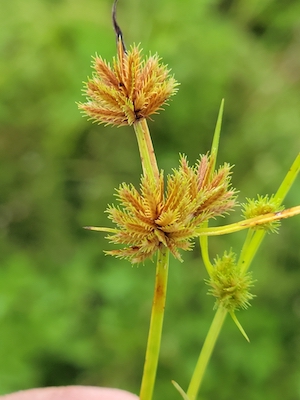Plants of South Florida · Plants by Conservation Area · Plants by County · Plants by Habitat Quick Search · Advanced Search |
||
|
|
||
 |
Cyperus cuspidatus Kunth Coastalplain flatsedge |
|
|
South Florida Status: Historical. Last collected in 1980 in northwestern Lee County. Taxonomy: Monocotyledon; Cyperaceae. Habit: Annual terrestrial herb. Distribution: Native to the southeastern coastal plain and tropical America. Wunderlin (1998) reports it as occasional nearly throughout Florida. South Florida Distribution: Charlotte, Collier, and Lee counties and the Monroe County Keys. South Florida Habitats: Moist hammocks and disturbed sandy soils. Protection Status: Not listed by any agency. Aids to Identification: Coastalplain flatsedge is most similar to Cyperus squarrosus. Coastalplain flatsedge differs from C. squarrosus in having scales retuse at the base of the awn (versus not retuse), and two lateral nerves on the scales versus six to eight in C. squarrosus (Wunderlin, 1998). Godfrey & Wooten (1979) has an illustration of both C. cuspidatus and C. squarrosus (as C. artistatus); Tobe et al. (1998) has an illustration of C. cuspidatus. References: Small, 1933a; McLaughlin, 1944; Long & Lakela, 1976; Godfrey & Wooten, 1979; Tobe et al., 1998; Wunderlin, 1998. Synonyms: None. Historical Context: The earliest known collection of coastalplain flatsedge is from the herbarium of Alvan W. Chapman. The specimen is labeled from Key West in 1843 (s.n., NY), but it is not certain if Chapman was the actual collector. It has not been collected in the Florida Keys since that time. Mary Francis Baker made the next collections in 1917 near Alva in Lee County (s.n., FLAS; 24, US), in the vicinity of what is now Caloosahatchee Regional Park. Gann surveyed this site with Lee County biologists Roger Clark and Rob Irving in January 2001. Potential habitat exists in the park, but it has been severely impacted by wild hogs and exotic pest plants. Olga Lakela made two collections in Collier County, the first in 1964 off of Lake Trafford Road west of Immokalee (24760, USF), and the other in 1965 in Royal Palm Hammock in Collier-Seminole State Park (29208, USF). R. “Bobby” Hattaway of the Florida Park Service has not seen this species in Collier-Seminole State Park despite numerous botanical surveys (R. Hattaway, personal communication, 12 January 2001). Habitat does exist near Immokalee at Corkscrew Swamp Sanctuary and Corkscrew Regional Ecosystem Watershed, but coastalplain flatsedge has not been observed or reported in that area despite surveys by numerous botanists. The last station to be collected was in Charlotte County about two miles north of the Lee County line along State Road 765 (Burnt Store Road), where Richard Carter collected it in 1980 (2656, FLAS). The habitat for this station was “bulldozed moist sandy site.” Gann observed the area in the vicinity of this station in 2000. The entire area had been cleared and was undergoing development. Comments: Coastalplain flatsedge is a small, sporadic, annual, ephemeral species that may be overlooked by botanists, or may have always been rare in South Florida. Godfrey and Wooten (1979) state that it prefers moist to wet open places, and is usually a colonizer. Specimens of this species in South Florida have been collected from September through November, when surveys should be conducted. Recommendations: · Survey Caloosahatchee Regional Park. · Survey appropriate habitats near historical locations in Charlotte, Collier, and Lee counties. · If plants are found, map and monitor known populations. |
||



